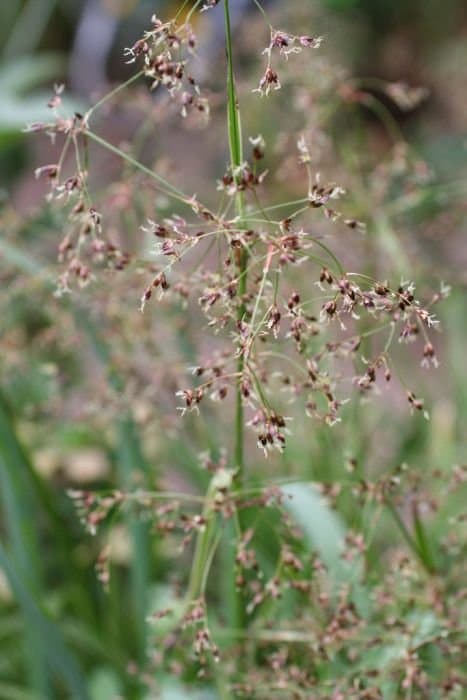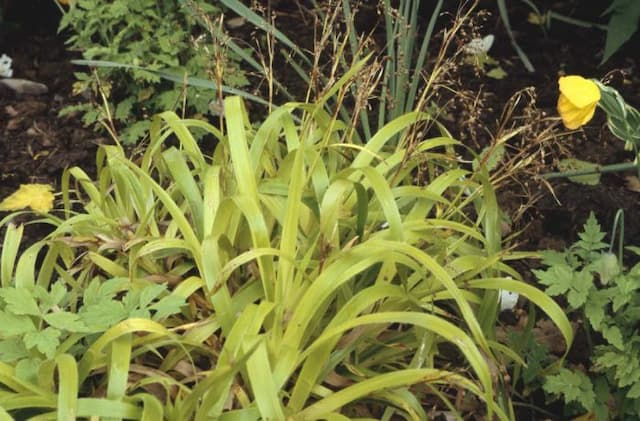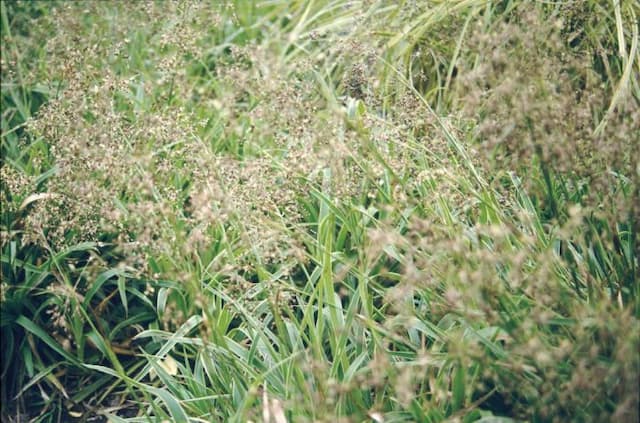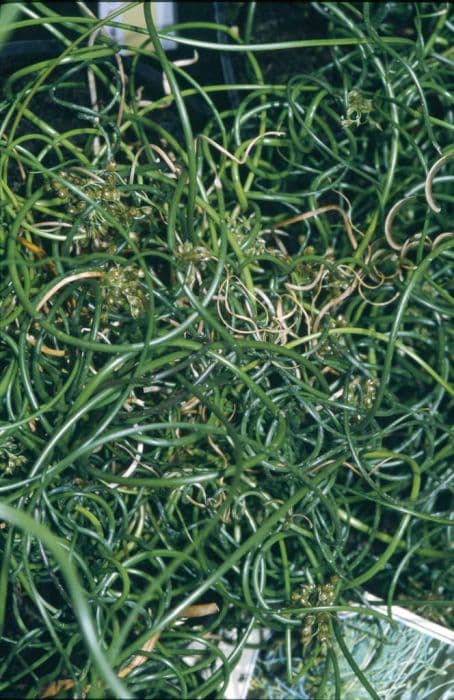Snowy Woodrush Luzula nivea

ABOUT
Luzula nivea, commonly known as Snowy Woodrush, is a perennial plant that is notable for its ornamental and tufted evergreen foliage. The leaves are narrow, elongated, and slightly curved, presenting a lush green color. The texture of Snowy Woodrush's leaves is typically smooth with a hair-like quality, giving it a soft and inviting appearance. During the blooming period, the plant produces flower clusters that rise above the foliage. These flowers are delicate and small, typically white or cream-colored, and they have a fluffy appearance, which contributes to the 'snowy' look suggested by its common name. The clusters are often arranged in a loose and informal manner at the ends of the stems, providing a light and airy visual effect. The Snowy Woodrush has a clumping habit, forming dense tussocks of grass-like leaves, which can add texture and contrasts beautifully with other plants in shaded garden areas or woodland settings. The overall aesthetic of Luzula nivea is natural and unrefined, with its simple and serene looks making it a popular choice for gardeners looking to create tranquil green spaces.
About this plant
 Names
NamesFamily
Juncaceae
Synonyms
Snowy Woodrush, Snowrush
Common names
Juncus niveus, Luzula nivea var. anthelminthica, Luzula nivea subsp. anthelminthica.
 Toxicity
ToxicityTo humans
Snowy woodrush (Luzula nivea) is generally not considered toxic to humans. There is no substantial evidence suggesting that ingestion of Snowy woodrush would lead to poisoning or produce harmful symptoms. However, as with many plants, individual allergies or sensitivities can exist, and it's always a good practice to avoid ingesting plants that are not commonly recognized as food.
To pets
Snowy woodrush (Luzula nivea) is not known to be toxic to pets. There are no well-documented cases of poisoning in pets such as dogs and cats from ingesting Snowy woodrush. As with humans, individual sensitivities could occur, so it's prudent to monitor pets and prevent them from consuming non-food plants, but Snowy woodrush does not pose a known risk of toxicity.
 Characteristics
CharacteristicsLife cycle
Perennials
Foliage type
Evergreen
Color of leaves
Green
Flower color
White
Height
1-2 feet (30-60 cm)
Spread
1-2 feet (30-60 cm)
Plant type
Herb
Hardiness zones
5
Native area
Europe
Benefits
 General Benefits
General Benefits- Erosion control: Luzula nivea, commonly known as snow rush, has a dense root system that can help stabilize soil and prevent erosion.
- Ornamental value: With its attractive white flower clusters and evergreen foliage, snow rush is often used in gardens and landscapes for decorative purposes.
- Wildlife habitat: Snow rush can provide cover and nesting materials for birds and small mammals, increasing local biodiversity.
- Drought tolerance: As a hardy plant, snow rush can survive in dry conditions, making it ideal for low-water gardens or xeriscaping.
- Low maintenance: Snow rush generally requires minimal care, resisting common pests and diseases, which makes it an easy addition to many gardens.
- Tolerates various soil types: This plant is adaptable to a range of soil compositions, from clay to sandy soils, allowing for versatile gardening applications.
- Shade tolerance: Snow rush can thrive in partially shaded areas, where other plants might struggle, thus filling in difficult spaces in the landscape.
 Medical Properties
Medical PropertiesThis plant is not used for medical purposes.
 Air-purifying Qualities
Air-purifying QualitiesThis plant is not specifically known for air purifying qualities.
 Other Uses
Other Uses- Luzula nivea, commonly known as the Snowy woodrush, can be used to create dense ground cover in shady garden spots, effectively suppressing weed growth due to its thick foliage.
- The fibrous leaves of the Snowy woodrush are occasionally utilized in traditional crafts for small-scale basket weaving and other fiber arts.
- The plant can be introduced to stabilize soil on slopes or embankments, as its root system helps to prevent erosion.
- Snowy woodrush serves as a natural habitat for various insects, providing shelter and breeding grounds for beneficial garden fauna.
- The ornamental seed heads of Luzula nivea can be used in dried floral arrangements, adding texture and rustic charm to bouquets.
- The grass-like appearance of the plant can be used to create a 'wild meadow' look in informal landscaping projects.
- In ecological gardening, Luzula nivea is incorporated into designs to mimic native undergrowth in forested areas.
- Due to its hardiness, Luzula nivea can be planted in urban green spaces to provide greenery with minimal maintenance needs.
- The visual contrast between its silvery foliage and darker green plants can be exploited to create striking patterns in garden design.
- As an indicator species in its native ecosystem, the presence of Luzula nivea can provide insights into the health of the local environment for research and conservation efforts.
Interesting Facts
 Feng Shui
Feng ShuiSnowy woodrush is not used in Feng Shui practice.
 Zodiac Sign Compitability
Zodiac Sign CompitabilitySnowy woodrush is not used in astrology practice.
 Plant Symbolism
Plant Symbolism- Snowy Woodrush: Luzula nivea, commonly known as Snowy Woodrush, could symbolize resilience and adaptability, as it is able to thrive in woodland environments which can be quite challenging.
- Purity: The white inflorescences of the Snowy Woodrush might symbolize purity and innocence due to their clean, snow-like appearance.
- Peace: The soft, subtle colors of this plant may evoke a sense of calm and peace, similar to a tranquil snowy landscape.
- Hardiness: Given its ability to withstand cooler climates, Snowy Woodrush could represent strength and the ability to endure difficult conditions.
 Water
WaterSnowy woodrush (Luzula nivea) prefers consistently moist soil but without waterlogging. Water the snowy woodrush thoroughly when the top inch of the soil feels dry to the touch, which may be approximately once a week, though this can vary depending on environmental conditions. During the active growing season in spring and summer, it might require more frequent watering, maybe twice a week, especially if the weather is particularly warm or windy. When watering, apply enough water to soak the soil evenly throughout the pot; this may be roughly around 1-2 gallons depending on the size of the plant and the pot. Reduce watering frequency in the fall and winter when the plant's growth slows down.
 Light
LightSnowy woodrush thrives in conditions with partial shade to full shade, making it suitable for understory planting or north-facing garden spots. An ideal location would be one where the plant is protected from the intense afternoon sun, ensuring that it receives filtered light throughout the day or consistent light in a heavily shaded area. Avoid placing snowy woodrush in direct, harsh sunlight as this may scorch the leaves and compromise the plant's health.
 Temperature
TemperatureSnowy woodrush is hardy and can withstand a broad range of temperatures, typically from around 50°F to 70°F. Although it can survive in temperatures as low as 20°F, it is ideal to avoid prolonged exposure to extreme cold below this point. The plant thrives best in temperate climates with cooler temperatures rather than in hot, arid environments.
 Pruning
PruningPrune snowy woodrush to maintain its shape and remove any brown or damaged foliage. Pruning can be done in early spring to remove old growth and encourage fresh, new shoots. This task is typically necessary only once a year. Cutting back the plant at this time also allows for better air circulation and promotes a more vigorous growth in the upcoming growing season.
 Cleaning
CleaningAs needed
 Soil
SoilSnowy woodrush prefers soil that is well-drained and moisture-retentive, with a preference for acidic to neutral pH, ideally ranging from 5.0 to 7.0. A good soil mix can be created with equal parts of loam, peat, and sand to ensure proper drainage and moisture retention.
 Repotting
RepottingSnowy woodrush does not require frequent repotting and can be repotted every 2-3 years or when it outgrows its current container. It's best to repot in the spring before new growth begins.
 Humidity & Misting
Humidity & MistingSnowy woodrush thrives in an environment with moderate to high humidity levels. It will do well in typical room humidity but appreciates a slightly more humid environment if possible.
 Suitable locations
Suitable locationsIndoor
Provide bright, indirect light and maintain moderate humidity.
Outdoor
Plant in partial shade, keep soil moist, and protect from strong winds.
Hardiness zone
4-8 USDA
 Life cycle
Life cycleLuzula nivea, commonly known as Snowy Woodrush, initiates its lifecycle as seeds, which, when conditions are favorable, germinate in moist, well-drained soil, typically in spring or autumn. The seedlings develop into tufted grass-like clumps with narrow leaves as they undergo vegetative growth. Over time, these clumps enlarge and establish a strong root system. During late spring to early summer, Snowy Woodrush produces tall flowering stalks topped with clusters of small, white, star-like flowers that contribute to pollination and subsequent seed formation. After flowering, seeds are set and dispersed, allowing for the possibility of new plants establishing nearby. In addition to seed reproduction, the plant can spread vegetatively by rhizomes, enabling the formation of dense colonies over time.
 Propogation
PropogationPropogation time
Spring-Early Summer
Propogation: The Snowy Woodrush, or Luzula nivea, is typically propagated through division, a method that allows gardeners to multiply their plants easily. The ideal time for this is in the spring or early autumn when the plant is not in active growth. To propagate by division, carefully lift the clump from the soil, ensuring a good amount of the root system remains intact. Using a sharp knife or spade, divide the clump into smaller sections, with each segment containing at least one growth point. Replant these divisions immediately at the same soil depth they were previously, spacing them about 12 to 15 inches (approximately 30 to 38 centimeters) apart to allow adequate room for growth. Water the newly planted divisions thoroughly to help establish them. This straightforward method ensures a higher success rate and maintains the genetic consistency of the plants.




